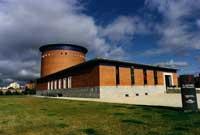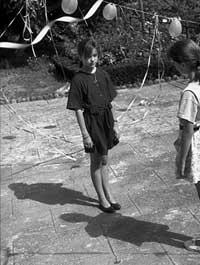Star school in Pamplona
1996/12/01 Kaltzada, Pili - Elhuyar Zientziaren Komunikazioa Iturria: Elhuyar aldizkaria
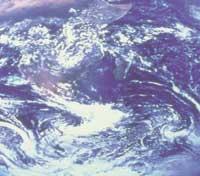
It opened for the first time in late 1993. Since then, thousands of visitors have approached the conferences organized by Izar Eskola. Last year the School broke all its records, with a total of 36,724 students. Since the start of the Izar School, more than 75,000 students from all over Euskal Herria and nearby communities have attended. If we look at the data of all the events, it is noted that the number of visitors has not stopped growing, so this year new courses have been organized in Pamplona.
With the support of the Department of Education and Culture of the Government of Navarra, the Star School is managed by the Public Society of the Planetarium of Pamplona. It coordinates the work of the Audiovisual Production and Programming Commission and the team of experts appointed by the Department of Education. In short, the preparation and supervision of the days and sessions that will be given throughout the course.
Renew or die
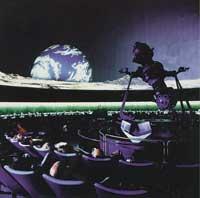
To date, Star School sessions were held exclusively throughout the course, from Monday to Friday, with a total of two sessions daily. Thus, the Planetarium offered the possibility of hosting some 35,000 students a year, although year after year the demands have been increasing and, although at first it seemed sufficient, the offer of Izar Eskola has remained small. The increase in the number of students per session was not the right solution, since the massive visits would be detrimental to the product offered.
As a result, three sessions a day will be held this year, with a total of 55,000 students. With this, the managers of Izar Eskola believe that the difference between supply and demand will be reduced. For example, last year the number of year-round visits was complete by January, so applications filed starting in February had to wait for a school to withdraw their application.
In any case, you don't just have to look at the amount. As we have been told from the Planetarium, the most important challenge this year is to improve quality. In this year's programming the courses of previous years have been maintained, but new activities are already being offered. Thus, this year's Star School has developed a new program aimed at schoolchildren between 6 and 18 years old. The following pages detail the contents, methodology and objectives of the courses to be worked on in each course.
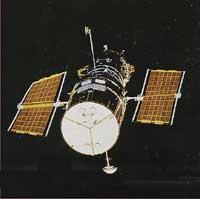
The needs of each group have been taken into account for their elaboration, so that the importance given to astronomy in teaching programmes has been analyzed in detail, different models and pedagogical resources have been developed after a detailed analysis of each group. The programming has been adapted to the needs of any school, so the sessions offered by the Izar School can be integrated into the dynamics of the classroom. As we have said before, it is not any school, but it is definitely a school.
Educational project
To support the programs offered by the Planetarium, the Pedagogical Commission of the organization has prepared a guide material. It has worked on the didactic material that can be used before the visit to awaken the attention of the students, and once the visit is completed the appropriate material is offered to make an assessment of what is seen and learned. This report includes questions, special activities, exercises outside the planetarium, etc. Year after year, this material is reviewed by the pedagogical commission and, for example, this year has adapted to new educational needs.
Annual description
“Human beings need the light and heat of the Sun to be able to live; by making stops on the Sun’s journey, we will better understand our life cycle.”
“We see stars in the sky when it darkens. Stars gather in groups forming images of animals and mythological characters. This allows us to know the stars better.”
“We see the Moon every night, however, our satellite undergoes important changes in appearance. To get to know him better we will also have the astronauts who have gone there.”
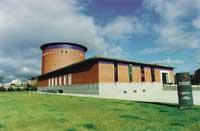
Directed to: In this first level activities are carried out aimed at children between 6 and 8 years old.
Objectives: The goal of this first level is to look at the sky and give data on what is shown before our eyes. It allows us to distinguish the stars and discover their importance in our lives. Based on the knowledge that students have of the hours, days, months or year, they work knowledge of time. Data on the basic tools created to meet human needs are also provided in a didactic way.
Contents: The Sun, the star of our day to day; constellations like Orio, Cygnus or Aquila; the Moon and its trajectory; and finally, the way to the Moon.
Annual description
“Facing the night sky you can see different stars. The different brightness and color of the stars will surprise us with our imagination. But the night sky also allows us to travel, of course, knowing the routes drawn by the stars.”
In the sky, besides the stars, there are more stars. Once the Moon is known in all its phases, we will know the rest of the planets of the Solar System.”
“Before you forget: Does heaven look the same from all places on earth?”
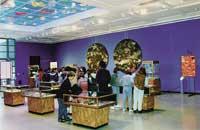
Directed to: Aimed at students between 8 and 10 years old.
Objectives: Stimulate student curiosity through direct observation. Not all stars are equal and their main characteristics are treated at this level. Teach to guide, through the representation of new constellations, work creativity and, finally, perform oral and written exercises to work the generated images.
Contents: the Sun and its daily journey; the brightness, color and size of the stars; the constellations such as Orion and the Great Bear in the Northern Hemisphere and the Southern Cross in the Southern Hemisphere; the planets, mainly Mars and Venus and, finally, the phases of the Moon.
Annual description“The Earth is a giant circus. His tent is not despicable: the same sky is the wonderful roof that is placed on us. And it has a great influence on our name. Every year season changes are renewed: in summer the sun's rays calm us, but in winter we look for its heat as crazy. The circus show begins...”. Directed to: For students aged ten to twelve. Objectives: To make known the movement of the Sun in the different seasons of the year, distinguishing the different cardinal points and analyzing what this distinction consists of. Comparing the light and heat that comes from the Sun in each season of the year, we will also explain the changes that this causes in our environment, thus arousing interest in our environment. Contents: Cardinal points; movement of rotation of the Earth, that is, day and night; stations and the main constellations and stars of each station; meteorites and shooting stars. |
Annual description
“As is known, during the day the sun appears on us and at night the sky is dressed as stars, we have seen it a thousand times, but unfortunately man has lost the habit of studying the sky. However, it does not take much wonder, at first glance many fascinating discoveries. But, of course, with the help of a telescope we will see everything much better. And what we cannot see can also be known through probes or spaces sent by man outside our planet.”
Directed to: For students aged 12 to 14.
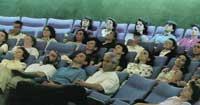
Objectives: The program at this level highlights the importance of direct observation to increase knowledge. The activities of the program, which also allow us to better understand the importance of astronomical phenomena, help us to know the work of those who have worked on these tasks. Finally, the program at this level explains the importance of technological development for science to advance.
Contents: The turn of the celestial vault, that is, the different stars that can be observed during the day and night; the stars and the light years; the galaxies and especially the Milky Way; the different components of the solar system, both visible to the naked eye and those that bring us different instruments.
“The Earth is not at all in space. Around is the Moon, constantly spinning; if we go further, there are other planets that also have satellites around them. And at the center of all this, the Sun illuminates us and calms us with its heat. So to speak, we are all relatives of the Sun, because in that same family human beings were born. The family photo book will teach us a lot about family relationships.”
Directed to: For students aged 12 to 14.
Objectives: It is a good way to acquire graphic knowledge about the Solar System. In fact, it shows us a simple way to assess the development of technology, while contributing to the development of the capacity for observation, measurement, interpretation and classification. With the excuse of the relative, the importance of teamwork is manifested at this level.
Contents: Sun, energy and source of life; view of the sky from Earth; all components of the Solar System, their trajectories, sizes, locations, etc.
Annual description“Our seat is at the center of the earth sphere and the Planetarium show starts right now. First, we will find the Mauna Kea observatory, and then we will go in search of a plane that has suffered a serious accident. Now we see the Earth as transparent, surrounded by stars, in the middle of the celestial sphere; we need other meridians and parallels to find that unknown body that emits Siro, Antares or X rays. Dead or dying stars are ideal for helping us. We are able to know the fascinating part of the universe through white dwarfs, black holes and the like. It’s going to start the show and it’s a great show.” Directed to: Aimed at students between 14 and 16 years old. Objectives: The program of this level aims to arouse interest in knowing the entire Universe through the study of several stars. Based on the knowledge of the atomic structure, it also serves to highlight the interdisciplinarity of science, the game offered to children of that age. Here we also get a better understanding of coordinates, terrestrial or celestial spheres. Students will also acquire basic astronomical knowledge, for which they will have to make their reasoning. Contents: From the terrestrial sphere to the celestial sphere: coordinates; arrangement of the stars; structure of matter and stars; last steps of the life of the stars. |
Annual description“How are the stars that make up the Universe? Why are they united? Why is it now day and night in other territories? Why not spend winter and summer everywhere? We go to the last end of the Universe, where we will find the answers to these questions.” Directed to: Aimed at students aged 14 to 18. Objectives: This program will help us to situate the Earth in the Universe and, at the same level, to better understand the phenomena that occur in our country. In fact, we will realize that the same phenomenon can be studied in different places and thus we will be able to know the explanations that were given about these phenomena in ancient cultures. Contents: The structure of the Universe and the creation of the Solar System; mentions of planets from different cultures; movements of translation and rotation of the Earth: seasons, day and night. |
Annual description“Those bright spots that look away at night, what are they? Analyzing the light transmitted by the stars, man has managed to obtain information of first magnitude. And so we have managed to complete the history of the Universe. The time has come to know the past and the history of these intense fires that flash from above every night.” Directed to: For students aged 16 to 18. Objectives: This last exercise shows us that what we know today about the Universe we have collected by collecting the contributions of many sciences. They tell us about the origin of the universe and that will help us to better understand our environment. To make all this known, emphasis will be placed on the importance of graphic representations. Contents: Stars, classifications and different types; the origin of the energy emitted by stars; the life of the Sun and its periods; our position in space; the birth of the Universe approaching the Big Bang theory. |
CONSIDERATIONS
- Undoubtedly, Navarros students are the most common of the Star School. In any case, the initiative seems to be also liked, since last year more than 30% of visitors arrived outside Navarra.
- It is said that everyone is the human law itself, so you have to try to offer yours to each group. The Izar School develops its activities in Basque and Spanish, according to the request of the center itself. Last year around 28% of students received explanations in Basque at the Planetarium in Pamplona.
- Izar Eskola is an offer for schools. Applications will be made at the Planetarium of Pamplona, by calling: 948 - 26 February 28

Gai honi buruzko eduki gehiago
Elhuyarrek garatutako teknologia




